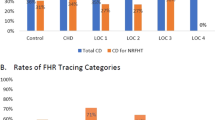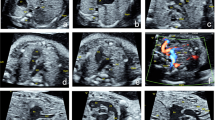Abstract
Objectives
We sought to describe the implementation and effectiveness of a statewide fetal tele-echocardiography program serving a resource-limited population.
Study design
In 2009, our heart center established six satellite clinics for fetal tele-echocardiography around the state. We retrospectively reviewed all fetal tele-echocardiograms performed through 2018. Yearly statewide prenatal detection rates of operable congenital heart disease were queried from the Society of Thoracic Surgeons database.
Result
In 1164 fetuses, fetal tele-echocardiography identified all types of congenital heart disease, with a sensitivity of 74% and specificity of 97%. For the detection of ductal-dependent congenital heart disease, fetal tele-echocardiography was 100% sensitive and specific. Between 2009 and 2018, annual statewide prenatal detection rates of congenital heart disease requiring heart surgery in the first 6 months of life rose by 159% (17–44%; R2 = 0.88, p < 0.01).
Conclusions
The present study provides a framework for an effective, large-scale fetal tele-echocardiography program.
This is a preview of subscription content, access via your institution
Access options




Similar content being viewed by others
References
Sharma S, Parness IA, Kamenir SA, Ko H, Haddow S, Steinberg LG, et al. Screening fetal echocardiography by telemedicine: efficacy and community acceptance. J Am Soc Echocardiogr. 2003;16:202–8.
Adriaanse BM, Tromp CH, Simpson JM, Van Mieghem T, Kist WJ, Kuik DJ, et al. Interobserver agreement in detailed prenatal diagnosis of congenital heart disease by telemedicine using four-dimensional ultrasound with spatiotemporal image correlation. Ultrasound Obstet Gynecol. 2012;39:203–9.
Satou GM, Rheuban K, Alverson D, Lewin M, Mahnke C, Marcin J, et al. Telemedicine in pediatric cardiology: a scientific statement from the American Heart Association. Circulation. 2017;135:e648–e78.
Schmidt KG, Ulmer HE, Silverman NH, Kleinman CS, Copel JA. Perinatal outcome of fetal complete atrioventricular block: a multicenter experience. J Am Coll Cardiol. 1991;17:1360–6.
Simpson LL. Indications for fetal echocardiography from a tertiary-care obstetric sonography practice. J Clin Ultrasound. 2004;32:123–8.
Pierpont ME, Basson CT, Benson DW Jr., Gelb BD, Giglia TM, Goldmuntz E, et al. Genetic basis for congenital heart defects: current knowledge: a scientific statement from the American Heart Association Congenital Cardiac Defects Committee, Council on Cardiovascular Disease in the Young: endorsed by the American Academy of Pediatrics. Circulation. 2007;115:3015–38.
Copel JA, Kleinman CS. The impact of fetal echocardiography on perinatal outcome. Ultrasound Med Biol. 1986;12:327–35.
Carvalho JS, Mavrides E, Shinebourne EA, Campbell S, Thilaganathan B. Improving the effectiveness of routine prenatal screening for major congenital heart defects. Heart. 2002;88:387–91.
Mosley BS, Simmons CJ, Cleves MA, Hobbs CA. Regional bias in birth defect prevalence rates for Arkansas: influence of incomplete ascertainment along surveillance system borders. Teratology. 2002;66(Suppl 1):S36–40.
Simmons CJ, Mosley BS, Fulton-Bond CA, Hobbs CA. Birth defects in Arkansas: is folic acid fortification making a difference? Birth Defects Res A Clin Mol Teratol. 2004;70:559–64.
Donofrio MT, Moon-Grady AJ, Hornberger LK, Copel JA, Sklansky MS, Abuhamad A, et al. Diagnosis and treatment of fetal cardiac disease: a scientific statement from the American Heart Association. Circulation. 2014;129:2183–242.
McCrossan BA, Sands AJ, Kileen T, Cardwell CR, Casey FA. Fetal diagnosis of congenital heart disease by telemedicine. Arch Dis Child Fetal Neonatal Ed. 2011;96:F394–7.
McCrossan BA, Sands AJ, Kileen T, Doherty NN, Casey FA. A fetal telecardiology service: patient preference and socio-economic factors. Prenat Diagn. 2012;32:883–7.
Cuneo BF, Olson CA, Haxel C, Howley L, Gagnon A, Benson DW, et al. Risk stratification of fetal cardiac anomalies in an underserved population using telecardiology. Obstet Gynecol. 2019;134:1096–103.
Medicaid.gov. Telemedicine 2019. 2020. https://www.medicaid.gov/medicaid/benefits/telemedicine/index.html.
Arya B, Bhat A, Vernon M, Conwell J, Lewin M. Utility of novel fetal echocardiographic morphometric measures of the aortic arch in the diagnosis of neonatal coarctation of the aorta. Prenat Diagn 2016;36:127–34.
Durand I, Deverriere G, Thill C, Lety AS, Parrod C, David N, et al. Prenatal detection of coarctation of the aorta in a non-selected population: a prospective analysis of 10 years of experience. Pediatr Cardiol. 2015;36:1248–54.
Familiari A, Morlando M, Khalil A, Sonesson SE, Scala C, Rizzo G, et al. Risk factors for coarctation of the aorta on prenatal ultrasound: a systematic review and meta-analysis. Circulation. 2017;135:772–85.
Gomez-Montes E, Herraiz I, Gomez-Arriaga PI, Escribano D, Mendoza A, Galindo A. Gestational age-specific scoring systems for the prediction of coarctation of the aorta. Prenat Diagn. 2014;34:1198–206.
Matsui H, Mellander M, Roughton M, Jicinska H, Gardiner HM. Morphological and physiological predictors of fetal aortic coarctation. Circulation. 2008;118:1793–801.
Patel C, Weeks B, Copel J, Fahey J, Song X, Shabanova V, et al. Fetal echocardiographic measures to improve the prenatal diagnosis of coarctation of the aorta. Pediatr Cardiol. 2018. [Epub ahead of print].
Sivanandam S, Nyholm J, Wey A, Bass JL. Right ventricular enlargement in utero: is it coarctation? Pediatr Cardiol. 2015;36:1376–81.
Vigneswaran TV, Zidere V, Chivers S, Charakida M, Akolekar R, Simpson JM. Impact of prospective measurement of outflow tracts in the prediction of coarctation of the aorta. Ultrasound Obstet Gynecol. 2019. [Epub ahead of print].
Rychik J, Donaghue DD, Levy S, Fajardo C, Combs J, Zhang X, et al. Maternal psychological stress after prenatal diagnosis of congenital heart disease. J Pediatr. 2013;162:302–7. e1.
Cabrera AG, Prodhan P, Cleves MA, Fiser RT, Schmitz M, Fontenot E, et al. Interhospital transport of children requiring extracorporeal membrane oxygenation support for cardiac dysfunction. Congenit Heart Dis. 2011;6:202–8.
Prodhan P, Fiser RT, Cenac S, Bhutta AT, Fontenot E, Moss M, et al. Intrahospital transport of children on extracorporeal membrane oxygenation: indications, process, interventions, and effectiveness. Pediatr Crit Care Med. 2010;11:227–33.
Lowery C, Bronstein J, McGhee J, Ott R, Reece EA, Mays GP. ANGELS and University of Arkansas for Medical Sciences paradigm for distant obstetrical care delivery. Am J Obstet Gynecol. 2007;196:534. e1–9.
2010 Census Results - United States and Puerto Rico. In: Bureau USC, editor. United States: United States Government; 2010.
Semega J, Fontenot K, Kollar M. Income and poverty in the United States: 2017. In: Bureau USC, editor. United States Census Bureau.
Hill GD, Block JR, Tanem JB, Frommelt MA. Disparities in the prenatal detection of critical congenital heart disease. Prenat Diagn. 2015;35:859–63.
Quartermain MD, Pasquali SK, Hill KD, Goldberg DJ, Huhta JC, Jacobs JP, et al. Variation in prenatal diagnosis of congenital heart disease in infants. Pediatrics. 2015;136:e378–85.
Bonnet D, Coltri A, Butera G, Fermont L, Le Bidois J, Kachaner J, et al. Detection of transposition of the great arteries in fetuses reduces neonatal morbidity and mortality. Circulation. 1999;99:916–8.
Khoshnood B, De Vigan C, Vodovar V, Goujard J, Lhomme A, Bonnet D, et al. Trends in prenatal diagnosis, pregnancy termination, and perinatal mortality of newborns with congenital heart disease in France, 1983–2000: a population-based evaluation. Pediatrics. 2005;115:95–101.
Lara DA, Fixler DE, Ethen MK, Canfield MA, Nembhard WN, Morris SA. Prenatal diagnosis, hospital characteristics, and mortality in transposition of the great arteries. Birth Defects Res A Clin Mol Teratol. 2016;106:739–48.
Tworetzky W, McElhinney DB, Reddy VM, Brook MM, Hanley FL, Silverman NH. Improved surgical outcome after fetal diagnosis of hypoplastic left heart syndrome. Circulation. 2001;103:1269–73.
Morris SA, Ethen MK, Penny DJ, Canfield MA, Minard CG, Fixler DE, et al. Prenatal diagnosis, birth location, surgical center, and neonatal mortality in infants with hypoplastic left heart syndrome. Circulation. 2014;129:285–92.
Vestergaard AS, Hansen L, Sorensen SS, Jensen MB, Ehlers LH. Is telehealthcare for heart failure patients cost-effective? An economic evaluation alongside the Danish TeleCare North heart failure trial. BMJ Open. 2020;10:e031670.
Witt Udsen F, Lilholt PH, Hejlesen O, Ehlers L. Cost-effectiveness of telehealthcare to patients with chronic obstructive pulmonary disease: results from the Danish ‘TeleCare North’ cluster-randomised trial. BMJ Open. 2017;7:e014616.
Cho YS, Park SE, Hong SK, Jeong NY, Choi EY. The natural history of fetal diagnosed isolated ventricular septal defect. Prenat Diagn. 2017;37:889–93.
Gomez O, Martinez JM, Olivella A, Bennasar M, Crispi F, Masoller N, et al. Isolated ventricular septal defects in the era of advanced fetal echocardiography: risk of chromosomal anomalies and spontaneous closure rate from diagnosis to age of 1 year. Ultrasound Obstet Gynecol. 2014;43:65–71.
Toth M, Holmes M, Van Houtven C, Toles M, Weinberger M, Silberman P. Rural medicare beneficiaries have fewer follow-up visits and greater emergency department use postdischarge. Med Care. 2015;53:800–8.
Gandhi S, Mosleh W, Shen J, Chow CM. Automation, machine learning, and artificial intelligence in echocardiography: a brave new world. Echocardiography. 2018;35:1402–18.
Narula S, Shameer K, Salem Omar AM, Dudley JT, Sengupta PP. Machine-learning algorithms to automate morphological and functional assessments in 2D echocardiography. J Am Coll Cardiol. 2016;68:2287–95.
Vinals F, Mandujano L, Vargas G, Giuliano A. Prenatal diagnosis of congenital heart disease using four-dimensional spatio-temporal image correlation (STIC) telemedicine via an Internet link: a pilot study. Ultrasound Obstet Gynecol. 2005;25:25–31.
Chaoui R, Abuhamad A, Martins J, Heling KS. Recent development in three and four dimension fetal echocardiography. Fetal Diagn Ther. 2019:1–9. [Epub ahead of print].
Acknowledgements
We would like to thank Dr Beverly Spray for assistance with statistical support.
Author information
Authors and Affiliations
Contributions
EHB conceived the study and composed the manuscript. RTC assisted in the composition of the manuscript. THB, DZ, SML, MGB, MSR, LLH, and CLL performed data collection and assisted in composing the manuscript. RAB conceived the study and helped to compose the manuscript.
Corresponding author
Ethics declarations
Conflict of interest
The authors declare that they have no conflict of interest.
Additional information
Publisher’s note Springer Nature remains neutral with regard to jurisdictional claims in published maps and institutional affiliations.
Rights and permissions
About this article
Cite this article
Bolin, E.H., Collins, R.T., Best, T.H. et al. Implementation of a statewide, multisite fetal tele-echocardiography program: evaluation of more than 1100 fetuses over 9 years. J Perinatol 40, 1524–1530 (2020). https://doi.org/10.1038/s41372-020-0677-2
Received:
Revised:
Accepted:
Published:
Issue Date:
DOI: https://doi.org/10.1038/s41372-020-0677-2



